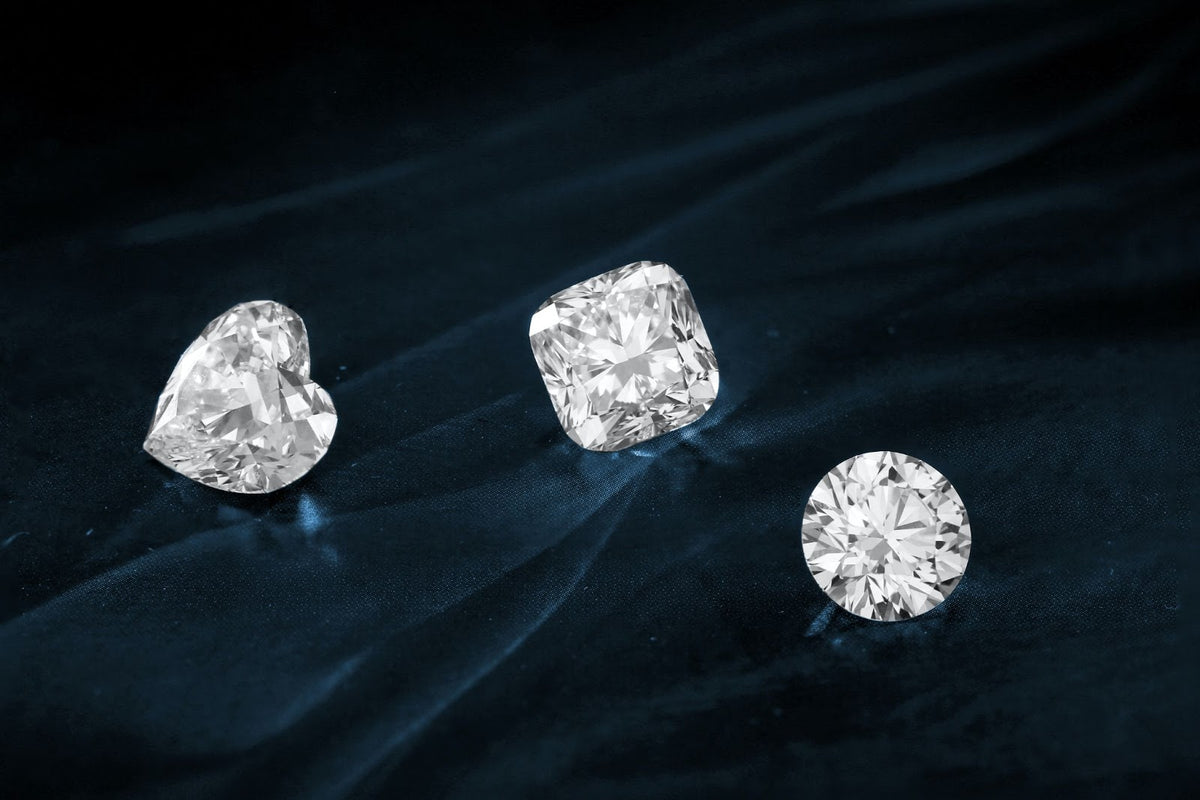Have you achieved something recently? We all go through seasons that demand more of us. Sometimes, you deserve to celebrate your hard work and resilience with decadent jewelry. Let's say you've decided to shop online for a tasteful diamond ring or for that pair of diamond flower earrings you've been eyeballing for the last couple of weeks to celebrate your commitment to yourself and your journey.
If you've never shopped for diamond jewelry before, all of the jewelry jargon could be hard to decipher. You know you'll want to choose a gem that shines brilliantly, but what do letters have to do with a jewelry's color? Let's decode some of the four C's so you have a better understanding of how to judge a diamond's color with a color chart (aka diamond color grading).
A Brush-Up on the Four C's
Maybe you've heard of the four C's before; cut, clarity, carat weight, and color. Most people are aware of that short list of qualities that determine a diamond's value, but they may not know what each of those words means practically. How can you ensure a diamond has the correct color? Let's look at each of the four C's to brush up on their meaning.
Cut
Diamonds are a product of the miraculous processes of nature. While these gems have inherent value on their own, high-quality craftsmanship matters when it comes to a diamond's cut. When a diamond receives an ideal cut, it can transmit light even more radiantly than before. One of the most noteworthy things to remember is that a diamond's cut influences its fire, brightness, and scintillation.
These three terms describe the way a diamond's cut impacts the way it interacts with light. Even to the untrained and naked eye, cut is one of the easiest things to spot.
Clarity
If you're unfamiliar with this term, you may be thinking clarity refers to transparency. Instead, this term refers to the absence of inclusions and blemishes. Natural earth-mined diamonds are formed due to a chemical interaction between carbon, heat, and pressure. One characteristic of an authentic earth-mined stone is the presence of imperfections called 'inclusions.' A less included diamond is worth more, and a diamond with increased inclusions is less desirable.
You can understand the worth of your diamond by understanding the scale used to determine the inclusion level in diamonds. Essentially, the scale lists diamonds from the low to high end like this: Included (I), Slightly Included (SI), Very Slightly Included (VS), Very, Very Slightly Included (VVS), Internally Flawless (IF), and Flawless (F).
Carat Weight
You may have already known that a carat represents how much a diamond weighs. Essentially, one carat is equal to two hundred milligrams. Because carat weight is so crucial to a diamond's worth, carat weight is judged on a one-hundred-point scale for the most accuracy. When all other factors are the same, a diamond with a greater carat weight will be more valuable.
Color
It may seem counter-intuitive, but a diamond's color grading does not refer to how much of its color is visible but rather the lack thereof. A chemically pure and structurally flawless diamond has no color. When trained gemologists grade a diamond's color, they do so under controlled lighting and with ideal viewing conditions.
They look to see if it falls in a normal color range. A higher color grade indicates a more valuable diamond. Let's take a closer look at what each color grade (which is really a letter grade) indicates.
- Colorless: Colorless diamonds are the most valuable diamonds due to their lack of color. These diamonds are chemically pure and fall under a D-F grading range. This includes d-color, e-color, and f color diamonds.
- Near Colorless: As their name implies, near colorless diamonds are the closest thing to colorless. They have a nearly indiscernible color to the untrained eye. On the color grading scale, these diamonds fall in the range of g color diamond, h color diamond, I color diamonds and j color diamonds.
- Faint and Very Light: In smaller diamonds, a very light and faint color grade will appear colorless when installed in a setting. However, in larger diamonds, the color will still be discernible. On the grading scale, these diamonds are a K-R rating.
- Light: A diamond with a light color grade indicates that the stone in question shows visible color, but not as dramatically as a fancy yellow diamond. On the color grading scale, this falls under the S-Z rating.
- Fancy Yellow: This color grade implies a diamond with a visible yellow tint. Though it may be excellent in cut, clarity, and carat weight, this color grade will diminish its value. It can range in yellow hues, including a light yellow to an almost orange in color.
Noémie's Commitment to Quality
Your jewelry should be trustworthy; you don't have time to weigh low-quality options. At Noémie, we're dedicated to always using high-quality materials. In every piece, you'll find 18-karat gold and VS clarity diamonds with F/G color grading. That means our diamonds are always colorless or near-colorless so that you can enjoy the finest diamonds at the most affordable prices.
Noémie Diamond Jewelry With Exceptional Color
As you search for the best quality jewelry, you'll want to find pieces that endure throughout your story. You want diamonds that will truly sparkle. Here are a few of our favorite pieces that feature a range of color in the F/G diamond grade.
The Noémie One Carat Diamond Eternity Band
Few pieces are quite as classic as a diamond eternity band. Our One Carat Diamond Eternity Band features glowing white diamonds all the way around an 18-karat band. You can customize this band by choosing your preferred metal in rose gold, white gold, black gold, yellow gold, or platinum.
An eternity band is named for the way it continues in a circle eternally and for its representation of eternal commitment. It's a piece anyone could wear, and everyone should have.
The Noémie Trois Hoop Diamond Earring
Are you looking for diamond jewelry with personality? You can try out our Noémie Trois Hoop Diamond Earring to dress up any outfit with a decorative flair. This diamond earring is designed to fit your right ear and to look like three hoop earrings, though you only need one piercing to display it.
This piece is hand-set with delicate white pavé diamonds that shimmer against their 18-karat gold metal base. Wear it alone, or pair it with a custom diamond pendant that shows off your originality.
The Noémie Diamond Tennis Bracelet
Here's another staple everyone should have. The tennis bracelet is a piece of jewelry that has been well-loved for decades. Its simple design lends itself to elevate any look, from your casual wear to black-tie attire. Our Noémie Tennis Bracelet displays stunning white diamonds set in 18-karat black gold, white gold, or yellow gold. This bracelet moves with fluidity as you do so that you can wear it throughout your day with ease.
The Noémie Baguette Diamond Band Ring
Baguette diamonds are highly regarded for their "hall of mirrors" lighting effects. This diamond's cut makes it an elegant choice to display in your jewelry with its exceptional clarity. Our Baguette Diamond Band is a gorgeous and sophisticated style that you can wear solo or with a glowing engagement ring. You can customize it with your color choice of 18-karat gold and have it engraved with a personal message to make it a one-of-a-kind piece.
To Sum It Up: Go for Colorless and Near Colorless
You now know all about the diamond color chart. Diamonds in the colorless range are the best, but at the end of the day, when you've decided to purchase a tasteful, classic diamond, it all comes down to personal preference. This information can still come in handy when shopping for diamonds, though!
You want something that’s going to shine brilliantly on your hand throughout all of your adventures. You can trust that it's authentically pure and expertly handcrafted because that's the Noémie way.
Sources:
4Cs of Diamond Quality by GIA | Learn about Diamond Buying | What are the Diamond 4Cs | GIA


